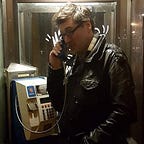Sean O’Hagan
and the Pan-National Avant-Garde
by Paul McDermott
I recently found a cache of old MiniDiscs (remember them) containing some of my Cork Campus Radio interviews from the mid-late 90s. This interview with Sean O’Hagan was recorded a few weeks prior to the release of The High Llamas’ Cold and Bouncy on 26 January 1997. The quality on the MD wasn’t great so I’ve transcribed the interview. What follows is Sean O’Hagan in his own words…
Note: This transcript has been lightly edited for clarity
Cold and Bouncy
Making Cold and Bouncy was an intensive couple of months where I wasn’t sure whether I was making a good record or a bad record. I still can’t decide, [laughing] I think half of it’s good. I think I experienced stress for the first time making a record, before that there was some pretty interesting touring. The tour with Pavement in Europe was very enjoyable and just recently, after we made the record, we did a tour of the States with Stereolab, which was very enjoyable as well. The States has been a big opening for us, it’s really taken to us and we’ve got a little bit of a following there. It’s a bit of a relief really because we don’t really get that much of a break in the UK.
It’s mainly Italian soundtrack writers and current German electronica
This record has less of The Beach Boys than before, it’s mainly Ennio Morricone, Piero Piccioni, Francis Lai and Michel Legrand. It’s mainly Italian soundtrack writers and current German electronica. It’s not so much the old German electronic music, it’s mainly people like Mouse on Mars, Microstoria and Oval — people like that.
There’s some really interesting things happening in clubs in London at the moment, it’s not a dance thing — in fact it’s almost anti-dance — where basically people are sampling maybe eight or 16 bars of a Piero Piccioni record and whacking it through a Moog and playing with the filters. That’s what the DJs are doing now, [laughing] and there’s no beats there, just basically standing around with a Bloody Mary.
On Hawaii most of it was written outside the studio, a very prepared record. We wanted to build in preventative measures to make sure that we didn’t make the Hawaii record again. An awful lot of Cold and Bouncy was done in the studio — all the counterpoint and a lot of the experimentation, all the electronics were all on the spot in the studio. Obviously the harmony and the toplines are written — the strings and the brass — and those parts are written, but the structures are done in the studio. We’re much more open to improvisation now.
I’ve been banging away writing songs in one form or another for a long time and I’m getting a little bit bored of the song-based thing, you know, vocal-led — verse chorus, verse chorus, middle eight, verse chorus. I don’t listen to any vocal-led music and my interest is in harmonic instrumental, experimental music or electronic music. Be it Erik Satie, Leonard Bernstein or Morricone, to Luke Vibert or Broadcast.
The pan-national avant-garde
The mainstream is occupied by extremely boring guitar-based retro music. I say retro in the worst possible way, not in the best possible way — because you can be retro and be inventive. I think most of the bands — I think you know who I’m talking about and I know who I’m talking about — are just interested in making pots of money and extending their adolescence well into their late-20s. I’m not interested in that, this sounds very pretentious but I think there’s a pan-national avant-garde — right from San Francisco to Chicago, New York to London, Paris, Munich, Cologne and Berlin — there is a sound.
I believe that this is my fraternity. I’ve got more in common with these people spread around the world than I have with the playlist in London on BBC Radio One
To Roccoco Rot from Berlin, in Cologne it’s Mouse on Mars and Microstoria, in London it’s the whole very happening electronica, drum and bass scene, there’s the post-rock thing that’s happening in Germany and Chicago with Tortoise and experimentalists like Jim O’Rourke. In San Francisco there’s Asphodel Records — people like Tipsy — and DJ Shadow. I believe that this is my fraternity. I’ve got more in common with these people spread around the world than I have with the playlist in London on BBC Radio One, which is basically dominated by the fallout from Britpop several years ago.
We’ve had a couple of bad gigs but we’re very lucky, we usually capture the audience one way or another. If we’re supporting somebody usually the audience starts off extremely suspicious, very stand-offish, but eventually we draw them in, eventually they’re rabbits.
Further Information
© Paul McDermott 2021, All Rights Reserved
